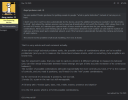Dave Merrill
Axe-Master
Yeah.Except that on many amps all those knobs interact with each other.
I still don't think that approach will solve it. Although it would probably improve things.
To do this right you'd need to "record" every combination of settings for every control.
That's a lot, especially if you model the "controls", ie block parameters, in as much detail as Fractal does.

